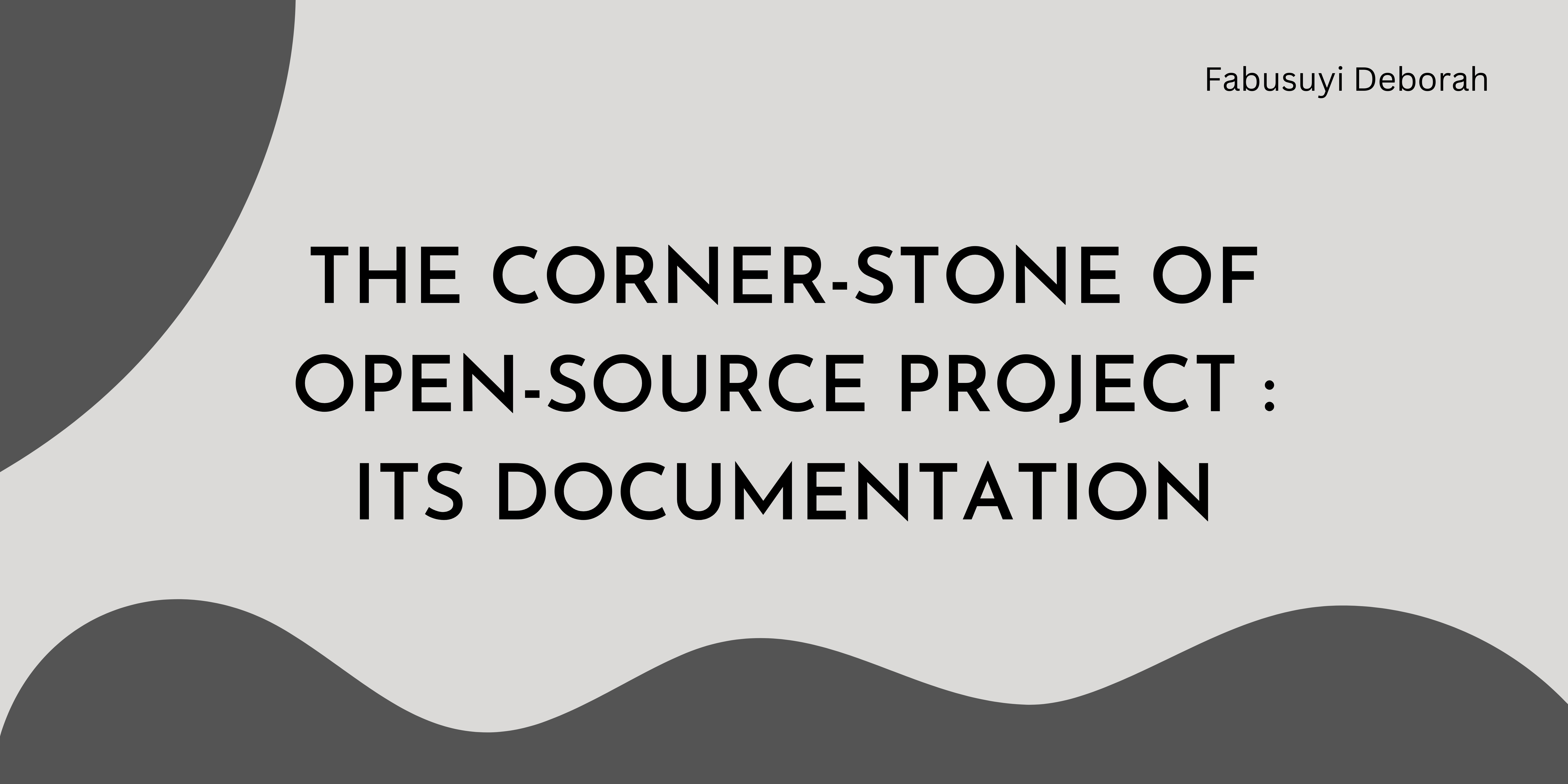The Corner-stone of Open Source Project : Its Documentation
 Deborah Fabusuyi
Deborah Fabusuyi
Introduction
Imagine you've stumbled upon an open-source project that perfectly aligns with your interests. You're eager to use it or contribute to it, but where do you start? The answer lies in the project's documentation.
Now think of Open Source Documentation as a guide to help a user get the most out of a project. It guides the user through the intricacies of the project, while also helping them understand the core principles of the project, how to use it and how to make their contributions.
In this article, we’ll look into Open Source documentation, types of open source documentation, discuss the importance , best practices for creating it and finally tools to streamline the process of creating an open source documentation.
What exactly is Open Source Documentation?
First things first, let’s define “Open source”. Open Source in simple terms means a type of software whose source code is freely available to the public to inspect, modify, enhance and distribute. For example: Linux operating system, Firefox web browser, MongoDB etc.
Now, Open Source Documentation refers to written materials associated with Open Source software. It provides information on the products use, functionality and maintenance. It includes details and information about the software’s features, installation configuration and usage. This documentation is usually made available to the public alongside the source code.
Open Source Documentation serves as a comprehensive resource for the developers, users and contributors, providing essential information about the project’s purpose, features and usage. At first, Open Source projects may feel overwhelming but with the help of a good documentation, it enables users and contributors to understand the project.
Types of Open-Source Documentation
Open Source projects usually have 3 types of documentation. Each of them catering to specific needs. They include Technical Documentation, Product Documentation and Guidelines.
Technical Documentation : This documentation is for developers. It delves deeply into the code base, explains the API, and demonstrates how to use the project's programming interface. It also includes introductory documents for the project, guidelines for developers working with the project, and instructions for configuring the development environment. API Documentation, Development guides and README are great examples of Technical Documentations.
Product Documentation : This documentation is targeted towards the users of the project. They include user manuals, quick start guides, installation guides, troubleshooting guides, FAQ etc. They essentially focus on the user's experience and guide the users into understanding the projects, its features and how to use the project.
Guidelines : This documentation is tailored to the contributors to the project. They help contributors understand how to navigate the project. The common types of Open Source project guidelines are :
Contribution guides : They are really important as they explain how to contribute to the project, including code submissions and bug reports/ fixes.
Style guides: provides information on the preferred style, formatting and naming conventions. It ensures quality and consistency in the code and contributions.
Code of Conduct : provides the expected behavior from contributors and community members.
Importance of Open Source documentation
A good documentation is of utmost importance either to the user of the project or the contributor to the project. Let’s take a look at how a good documentation helps the users as well as contributors to an Open Source project.
For Users:
Improved User experience : A good documentation helps the user understand how to utilize the project effectively and get the most out of it. It provides a faster solution to issues a user might come across when using the project.
Easier adoption and usage of the software: A clear and concise documentation makes it easier to understand the software’s features and functionality. It reduces the learning curve and makes the software more accessible to a wider range of users.
Problem-Solving : A detailed documentation can assist users in troubleshooting issues and finding solutions independently. This decreases dependence on support personnel while improving the overall user experience.
Reduced Support Costs: A good documentation can help minimize the number of support questions, saving time and resources for both users and developers.
For Contributors:
Clearer understanding of the project : To be able to contribute to a project, there’s a need to understand the project. Having good documentation helps the reader understand the project and how to get started with their contribution.
Effective Onboarding : Good documentation facilitates a smooth onboarding process for the contributors. It helps them get more familiar with the project’s code base, workflow and the necessary details needed for them to make their contributions.
Enhanced Collaboration: Clear and concise documentation creates a common ground for contributors, ensuring that everyone understands the project's goals, architecture, and coding norms. Contributors can readily get the information they need to carry out their tasks, reducing delays and misunderstandings.
Best practices to achieve a good Documentation
From what we’ve discussed so far, it can be seen that writing good documentation for your open source project is really crucial. To be able to achieve a good documentation that would cater to the needs of your users and contributors to the project, here are a few things to do.
- Write in a clear and concise manner to enable your readers easily understand what you are putting out there. It is important to avoid the use of complex technical jargons that would confuse your readers as the essence of the documentation to to improve the user experience
Organize your documentation in a structured way and pattern. To achieve this, it entails arranging your information logically using headings, subheadings, and bullet points. Your documentation should follow a structured pattern, everything should flow well from top to bottom and it should be easy for readers to follow
Write with the user’s needs in mind. It is important to put yourself in their shoes, your documentation should be a helpful resource, not a barrier to entry. Explain concepts as clearly as possible; do not assume. You may include code snippets to help explain specific concepts, anticipate common questions, and provide straightforward solutions/answers.
Keep your documentation up-to-date by updating it whenever changes are made to the project. Your documentation should be sent out alongside the code, as the code base is being updated, the documentation should also be updated.
Provide clear instructions on how to contribute to the project. This way people who are willing to contribute can find their way around the project while also making their changes easily.
Check for errors, inconsistencies, or outdated information. Also ask for feedback from your user, this helps improve the documentation.
Last but not the least would be leverage on tools that can help to achieve good documentation. There are lot of tools out there you can use to
Tools to leverage on to create a good Documentation
As earlier said, there are lot of tools you can utilize to create a good documentation that users can easily look through and understand. Here are a few of them.
Sphinx : a popular tool for creating technical documentation, especially for Python projects. It supports various output formats (HTML, PDF, LaTeX) and has a rich ecosystem of extensions.
Doxygen : a tool for generating API documentation from source code comments. It supports various programming languages and can produce documentation in HTML, LaTeX, and other formats.
MkDocs: a simple, fast, and configurable documentation generator that uses Markdown for writing content. It's well-suited for smaller projects.
Read the Docs: a hosting platform for documentation built with Sphinx or MkDocs. It simplifies software documentation by building, versioning and hosting of your docs.
Git : Git allows you to track changes to your documentation over time. This means you can easily revert to previous versions if necessary, and it also helps prevent accidental deletions. It helps in continuous updates to the documentation.
You can look through each of the tool's documentations to have an in-depth understanding of how they work and how to get started with using them.
Conclusion
To conclude, a good documentation determines how well a project is understood and utilized. It's essential to have a clear and concise documentation that caters for the needs of everyone looking to use an Open Source project.
From the article, it can be seen that by investing time and effort into creating thorough, well-structured, and accessible documentation, you not only improve the user experience but also ensure your project's sustainability.
The next time you come across an Open Source project that catches your attention, don't be afraid to dig in; the documentation will be your guide to using or contributing to the project.
Resources
https://opensource.googleblog.com/2018/10/building-great-open-source-documentation.html
Subscribe to my newsletter
Read articles from Deborah Fabusuyi directly inside your inbox. Subscribe to the newsletter, and don't miss out.
Written by

Deborah Fabusuyi
Deborah Fabusuyi
I am Fabusuyi Deborah, but you can call me "Dherrbie". I am a Junior frontend developer, that is passionate about building responsive websites and bringing life to Designs. I'm also passionate about breaking down complex topics into simple and concise articles for Technical and Non-technical readers.